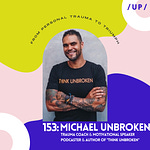If you’re involved in the Spoonie community on Instagram, you’ve probably come across Ariel of @carpe_that__diem, who blogs about living in a disabled trans agender body, mental health, working with a SD (service dog), and death positivity. An academic by training and trade, Ariel’s perspective is eloquent, enlightening, and engaging. He uses this interview (in two parts) to dive into the intersections of invisibility in his life – as a disabled person living with post-hysterectomy endometriosis, Hashimoto’s disease, and a Cluster B personality disorder; as well as both inner and outer perception of his gender identity, and how his medical conditions have interfered with his self-realization. A complex and candid interview, Ariel paints pictures of frustration – and triumph – in his survival story. (And a heads-up that if you hear any barking in the background – those are Ariel’s pups saying hello!)
Tune in as Ariel shares…
- his experience of disability, invisibility, and gender
- that he had a pediatric diagnosis of hypothyroidism and Hashimoto’s disease
- that his doctors and parents advocated for him from a very young age
- this his body chemistry shifts constantly, and he has had to constantly adjust his thyroid medications reactively
- that he originally wanted a hysterectomy as the first step of bottom surgery for gender affirmation – but it became a priority because of chronic pain associated with endometriosis
- that he lacked support from his peers as he developed – and was openly judged for his early development by both peers and adults
- that he lived in undue suffering for years – not realizing that his menstrual pain was abnormal
- that he struggled with the emotional AND physical process of coming to terms with his own gender identity, which was compounded by gynecological pain
- the Da Vinci robotic method for hysterectomy – and how his surgery was single-incision through his belly-button
- that the results of his initial tests (pre-hysterectomy) had been misinterpreted; as a result, recovery was devastating – and there is now a very real risk that there may still be active endometrium continuing to grow in his body. As such, he has to keep on top of that with future imaging and surgeries
- that removal of the cervix only is not typical of gender-affirmation surgery
- that the immediate recommendation post-hysterectomy was a full vaginectomy, which he may still have to do
- that because of these surgical complications, his gender affirmation is in limbo – he must keep a female gender marker in order to continue to properly treat his endometriosis through health insurance – ultimately, his body is still interfering with his gender identity
- the common misconception that a hysterectomy is a “cure” for endometriosis – which it isn’t. It is only a treatment, not necessarily a cure
- that he still lives with chronic pain due to the persistence of endometriosis, as well as cramps and bloating
- that he also lives with borderline/bipolar 2/Cluster B personality disorder – and that this disorder has largely been misunderstood because of its presentation in media
- that borderline personality disorder is really scary for the person who lives with it – he feels he lives with a monster
- that the medical community has not yet come to a conclusion as to the cause of Cluster B personality disorder – whether it is hereditary, trauma-related, or otherwise
- how a Cluster B personality disorder manifests – and what “splitting” looks like
- that Cluster B personality disorders are notoriously medication-resistant
- that he treats his mental health disorders with CBT (cognitive behavioral therapy), DBT (dialectical behavioral therapy – blunt de-escalation strategies that address negative feelings), and various medications
- that his partner has been an incredible support across the board – but that he also presents as cis-gender male, and tends to be taken more seriously than Ariel in many situations, particularly medical – because of “the enormity of his masculinity”
- that his service dog, Caliban, gave him back a life outside of the house – and in the world
- what it means to be transgender, and how he has undertaken his transition
- that he considers himself agender – which is part of the non-binary spectrum
- that being agender means he can make a self-determination about what masculinity and femininity means to him
- that he has tried using gender-neutral pronouns before – but it was an uphill battle to argue the use of they/them (despite its existence in language as a whole) – so he started using “he/his” instead – not because he disagrees with the use of gender-neutral language, but because with everything else on his plate, he wasn’t willing to die on that hill to prove his point – or to legitimize his existence
- that even Marsha P. Johnson lived with multiple disabilities and mental illness – and her calling card was “I may be crazy, but that don’t make me wrong”
- the medical prejudice that queer-identifying individuals still come across on a daily basis
- TRANSCARE from the University of Iowa – and how everybody in the medical world has to get comfortable communicating effectively with their patients in order to create an affirming and safe environment














Share this post